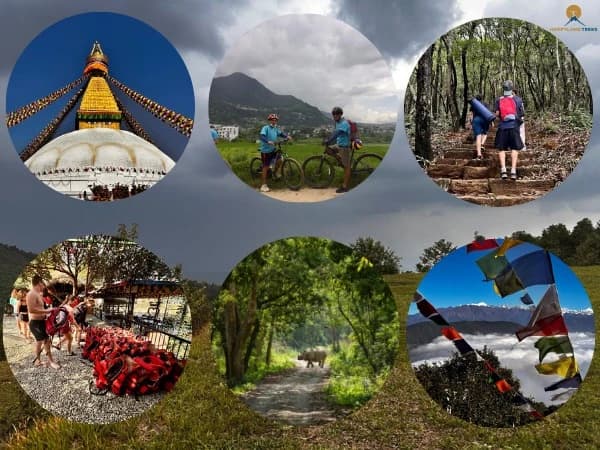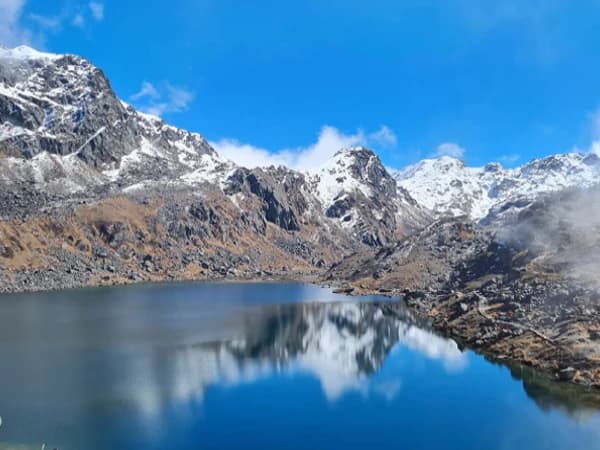Key Difference Between the Everest Base Camp Trek in Nepal & the K2 Base Camp Trek in Pakistan
| Matrics |
Everest Base Camp Trek |
K2 Base Camp Trek |
| Base Camp Altitude |
~5,364 meters |
~5,150 meters |
| Maximum Altitude |
Kala Patthar (5,550 meters) |
Gondogro La Pass (5,585 meters) |
| Total Distance (Round-trip) |
~130 km (or depending on route) |
~160 km |
| Total Duration |
12 - 14 days |
14 - 21 days, sometimes more, depending on itinerary |
| Difficulty Level |
Moderate to challenging |
CHallenging to strenuous |
| Terrain Type |
Well-marked trails, many villages, teahouses, mixed terrain from forest to snow, rocky glacial moraines |
More rugged & glacial terrain, less defined trails, glacier travel (Baltoro), etc. |
| Total Cost |
USD 1,650 - 3,300 per person |
USD 2,100 - 8,900 per person |
| Best Time |
Spring (March - May) & Autumn (September - November) |
June - September |
| Popularity |
Highly popular: One of the most trekked routes in the world |
Less frequented: Far fawer trekkers each year |
| Availability |
All Year |
June - September |
Route & Geography
Mount Everest
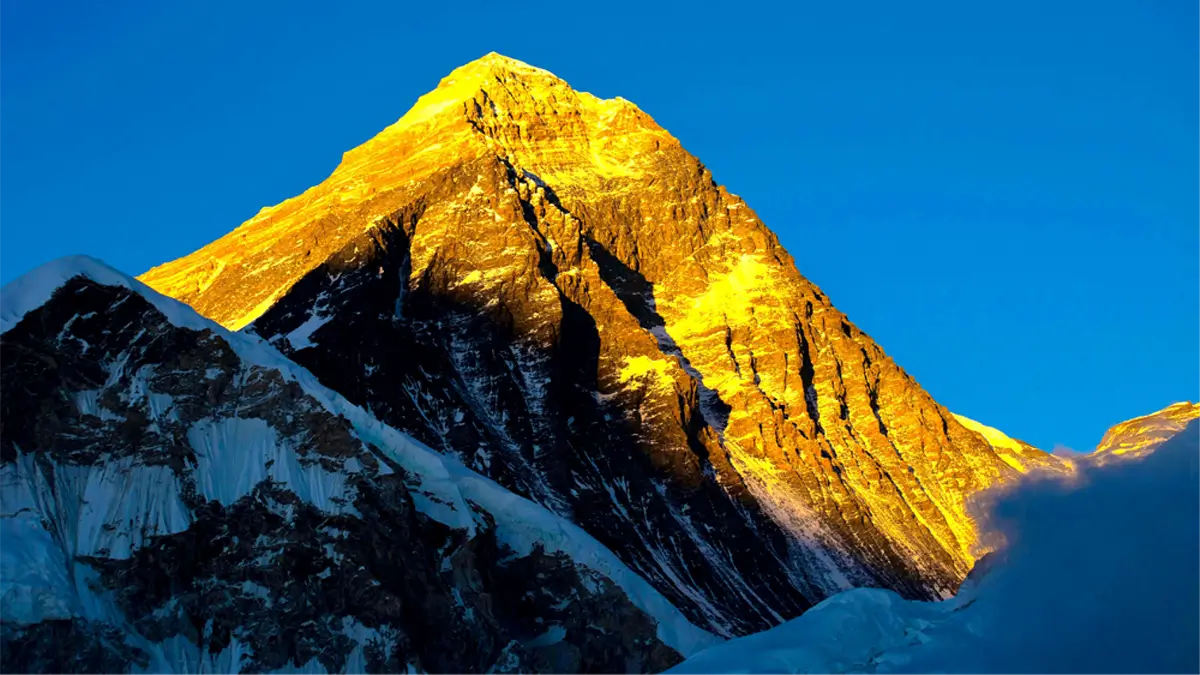
Everest Base Camp (EBC) is located in the Khumbu area of Province No. 1, Nepal, South Asia. situated within the Everest-Sagarmatha National Park. The usual means of access to the Everest region will be to fly domestically in Nepal (from Kathmandu) to Lukla. or Kathmandu to Ramechhap Manthali Airport drive and fly to Lukla.
After you land in Lukla, you will need to traipse through a beautiful valley with views of rhododendron, suspension bridge, rocky moraines, juniper, pine trees that turn to alpine meadows nearby Lobuche and Gorak Shep, where we will typically see the edge of a glacier.
One of the highlights of the EBC trekwill be Kala Patthar. Where else do you get to wake up to incredible views at sunrise of Everest, Lhotse, and Nuptse all from the same location? The route to EBC is very clear with tea houses and villages a few hours or so of trekking along the route.
Mount K2

K2 Base Camp (K2 BC) is located within the Karakoram Range of Gilgit-Baltistan, Pakistan. The trek begins in Islamabad or Skardu and requires an extensive jeep drive to remote valleys into the Baltoro Glacier system.
K2 BC is rugged, icy, and rough, while mainly barren river valleys, glacier moraines, crevasses, icefalls, and snow fields depending on the weather, and there are no permanent villages for accommodations, thus while stationed at K2 BC you will be camping.
EBC – Everest Trek Sample Route:
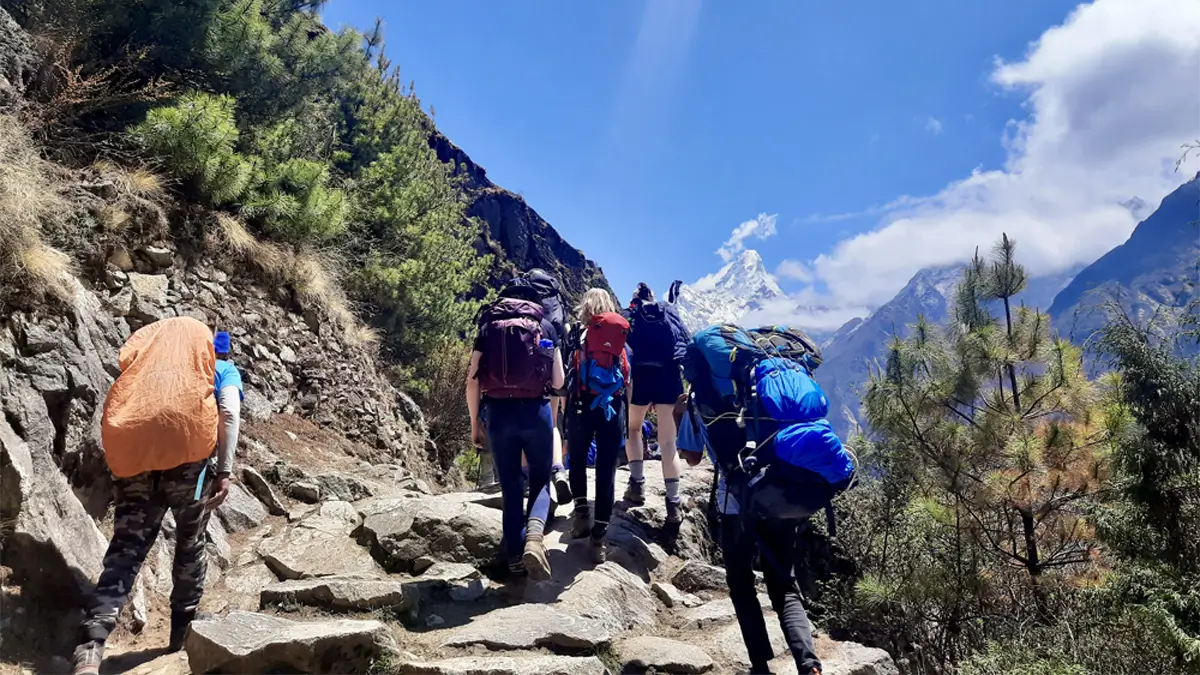
- Kathmandu (Nepal, 1,400 meters): pre-trek preparation, gear, permits.
- Lukla (2,860 meters): flown in from Kathmandu to begin trekking.
- Phakding (2,610 meters): first overnight stop, gentle terrain along the river.
- Namche Bazaar (3,440 meters): key acclimatization stops and major Sherpa town.
- Tengboche (3,860 meters): monasteries, first big climb through alpine forest.
- Dingboche (4,410 meters): second acclimatization stop and views of high peaks.
- Lobuche (4,910 meters): rock and moraine terrain begins.
- Gorak Shep (5,160 to 5,200 meters): last settlement before base camp.
- Everest Base Camp (5,364 meters)
- Kala Patthar (5,555 meters): an optional summit-view point. Early morning sunrise or evening sunset.
- Return follows a reverse path, with rest or variation (e.g. via Pheriche, Tengboche).
K2 Base Camp Trek Sample Route:
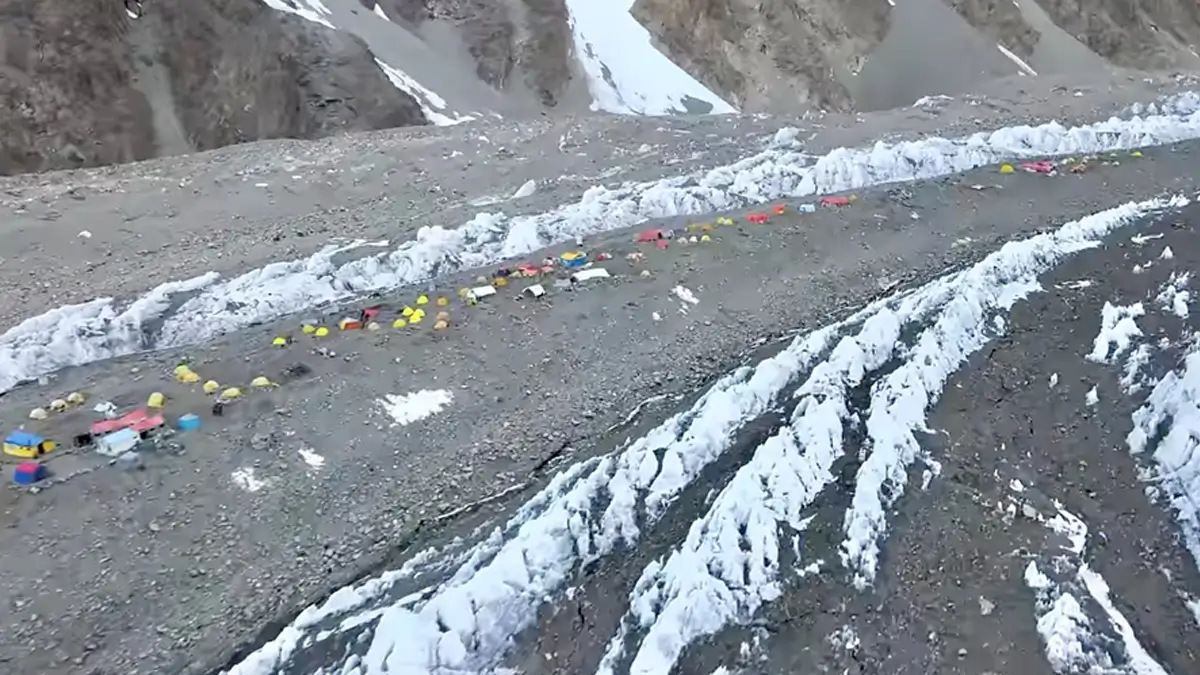
- Islamabad / Skardu: travel by road or flight to Skardu; then jeep/road to the railhead.
- Askole (3,100 meters): last village and the starting point of the trek.
- Jhola (3,300 meters): along the Braldu River and landscape starts to become barren.
- Paiju (3,450 meters): rest/acclimatization point and first view of Baltoro Glacier snout.
- Khoburtse (3,800 meters): You will begin traversing glacial moraine.
- Urdukas (4,050 meters): perched above glacier edges with dramatic peak views.
- Goro II (4,300 meters): more challenging glacial terrain.
- Concordia / K2 Base Camp (5,250 meters)
- (Optionally, side trips or passes like Gondogoro La (5,585 meters) for return or extension)
Altitude Profile
The journey starts at EBC in Lukla (2,860 meters) and proceeds through well-known stopovers Namche Bazaar, Tengboche, Dingboche, Lobuche, and Gorak Shep up to Base Camp at 5,364 meters.
totalling at least 10 days of trekking and finishing at stunning Kala Patthar at 5,550 meters.
During all those trekking days, you have two acclimatization days strategic at Namche Bazaar and Dingboche to allow your body to adapt to the height for safety from altitude sickness and enjoy the mountains.
The K2 Base Camp Trek starts from Askole (3,040 meters), and it steadily gains altitude to camps with little population via Jhola, Paiju, Urdukas, and Goro II, for less populous camps on include final stop at Concordia and finally K2 Base Camp at 5,150 meters.
Although long, the trek is gradual on the Baltoro Glacier which makes altitude management very important for the terrain in this remote trek.
You will definitely want to follow the midcamp rest days, stay hydrated and monitor for AMS, HAPE, or HACE. Help is far more difficult to reach on K2 than at well-connected EBC in Nepal.
Nevertheless, EBC is preferable if you are looking for a high-altitude trek which is well-structured, has a support system, and acclimatization. If you are looking for remote glacier trekking take on K2.
Weather Patterns & Climate Conditions
On Everest Base Camp, daytime temperatures in the lower valleys are shockingly mild but once you reach higher camps, such as Gorak Shep or Kala Patthar, temperatures are below zero. Most of the nights are cold and extreme snowstorms or high winds can come out of nowhere.
But the K2 trek is on a whole other level of intensity. Daytime temperatures in the valleys are pleasant escapes from the heat of summer, but the Baltoro Glacier or icefield sections are painfully cold. At night, the higher camps are still well below zero, plus the unpredictable weather of the Karakoram with violent storms and extreme high winds.
Again, you need to be well-packed for both treks with appropriate layers.
Cost Breakdown
In order to trek to Everest Base Camp in Nepal, you will need to buy some permits first. The Pasang Lhamu Municipality costs approximately USD 23, then you will also need the Everest - Sagarmatha National Park entry permit, about USD 23.
But permit fee costs can be changed a little more or less.
More or less thinking like Nepal, to get to Lukla from KTM will cost you roughly USD 223 to 270 one way for the flight, to hire a guide will cost roughly USD 35 - 80 for the guide, and USD 25 to 40 for the porter. Per day.
Food are available meals and lodging will be in the tea houses, around USD 4 to 15 per meal and USD 10 to 200 per night. All together a regular 12 to 14 days EBC Base Camp basic package (with guide included and meals) is usually in the range of USD 1650 to 3300. Per person.
Now, the K2 Base Camp Trek in Pakistan is going to be more expensive overall. The permit prices are a little higher, around USD 150 to 200 for the K2 Base Camp permit, then there is also a restricted area permit for Baltistan. You will also need to budget for the flight to Skardu (USD 150 to 250), and the jeep ride to Askole is an extra USD 50 to 100.
Next, guide and porter fees around USD 40 to 70 and USD 25 to 45 per day respectively. As camping is critical along Baltoro Glacier, food costs are included in the trek package, (over half the cost just for food) and stay is included in camping.
In all, a K2 Base Camp full trek package, 14 to 22 days, including guide fees, porter, camping gear, and transportation, on average, costs between USD 2,100 to 8,900.
So, in brief, EBC – Everest is the cheaper option, while K2 BC is the more expensive, longer, tougher, expedition, all done under the auspices of camping.
Difficulty Level
The trek to Everest Base Camp is usually rated as moderate to vigorous, with 5 - 8 hours of hiking on the trail each day. Each day you will ascend a reasonable amount of altitude (generally 400 to 800 meters) and hit an apex of 5,364 meters at base camp Mount Everest.
The trails are firm and uncomplicated to follow, and porters can carry heavier packs while you bring a lighter daypack.
The K2 trek, however, is a step up in every area! Running from 14 to 22 days, it also has you trekking for 6 - 8 hours a day, and generally you climb the altitude of 500 - 800 meters each day to the K2 Base Camp 5150m. If you're hitting Gondogoro La Pass, then you have to climb 5,585m.
The trails are rough with lots of glacier crossings, lots of moraine to hike, and also river fording to do, and you are camping every night. Porters have a bit more for heavy gear, but you will also have a slightly heavier daypack.
There is no technical climbing, but this trek requires serious mental toughness from isolation, extreme remoteness, and few facilities.
It could be summed up like this: Everest Base Camp is an adventure in high altitude that balances physical challenge with logistical support; K2 is for people with a desire for true wilderness, glacier trekking, and mentally and physically challenging journey.
Scenery, Culture & Experience
If you go on a trek to Everest - EBC, you will be in close proximity to Everest, Lhotse, Nuptse, Ama Dablam, Pumori, Tabuche, and many more, including culture. You will walk past significant destinations on the trek, such as Tengboche Monastery, Kala Patthar, and Thukla Pass Memorial.
The trail will also take you through beautiful rhododendron forests, alpine meadows, glacial moraines, and icefalls, where you may see some wildlife, including Himalayan tahr, musk deer, or occasionally, snow leopards and Himalayan griffon vultures.
Finally, you will experience Sherpa communities and their hospitality, and Tibetan Buddhism, complete with prayer flags, stupas, and gompas.
On the other hand, if you were to trek to K2 Base Camp, you would be surrounded by giants such as K2, Broad Peak, Gasherbrum I & II, Masherbrum, and Trango Towers. You would pass destinations such as Concordia, Baltoro Glacier, and Gondogoro La.
You will encounter rugged trails, with some glacier crossings, rocky moraines, and not as many alpine meadows.
You will also see wildlife such as markhor, ibex, brown bears, and golden eagles! The people you would meet in Pakistan are Balti people who are observant of their Islam cultural traditions.
Best Time to Trek
Timing can greatly influence the experience and journey of your dream trek, and variations in timing can be quite considerable. When it comes to EBC, I always recommend Spring Season (March through May) and Autumn Season (September through November).
But this Everest Base Camp trek people do all the months of the year, whenever they have time and availability all year.
In Spring, you can expect blue skies, pleasant weather, and the valleys will be filled with blooming rhododendrons - it will feel magical.
Autumn is also clear and dry, while evergreen trees remain lush, trails have settled from the monsoon rains, and it likely has the clearest views of Everest, Lhotse, and Ama Dablam.
Now, the K2 Base Camp Trek has added complication due to the remote nature of the Karakoram glaciers.
It's flexible, but best trekking season (June to September) is the summer season, when the weather is the most stable and not crazy snowy.
Some climbers with more adventurous spirit go in pre-monsoon (April to May) or post-monsoon (September to October) for the chance of fewer crowds, but I would recommend avoiding these secondary seasons if you could be any less predictable.
Everest Base Camp Trek vs K2 Base Camp: Which Trekker Should Choose Which?
Deciding between the K2 trek and EBC trek comes down to who you are and what you want from the expedition - and this is a very personal decision! Here's the breakdown:
- Experience: If you are a beginner to high-altitude trekking but have some other moderate experience, EBC – Everest would be a better choice for you!
If you want to trek to K2 Base Camp, then you should not go there as a beginner adventurer. K2 BC is suited for experienced trekkers accustomed to rugged terrain and remote glacier trekking.
- Fitness: The level of fitness required for EBC is basic fitness level is fine not required technical experience, but flexibility basic exercise would be more helpful while walking uphill, downhill in the high altitude. like: walking, running, aerobic, hiking, rowing, cycling, paddling, jogging, etc.
Very similar as Everest Base Camp fitness level as for K2 Base Camp as well. If you want you can do more advance exercise but basic exercise would be fine.
- Time frame: EBC trek is shorter, as it can take 12 to 14 days including acclimatization. The K2 trek is about 14 to 22 days. Just that, it is longer. But sometimes takes even longer time in the mountains.
- Budget Cost: Overall, the Everest trek has many options depending on your comfort needs. Between 1,400 USD – 3,300 USD. Per person.
The K2 trek would be more expensive due to the remote access, longer duration days, and logistical standpoints you may encounter.
- Comfort vs. Wilderness: The base camp at Everest in general should feel more comfortable with tea houses, hot food daily and basic facilities. K2 Base Camp would be remote, and essentially a wilderness experience.
- Weather: Many aspects of both treks would be high altitude always however the K2 Base Camp has colder temperatures, strong winds, and snowstorms may occur during the trek. EBC is slightly milder with uncertainties of weather.
Weather can be changing any time in the mountains so I can’t tell exact.
In conclusion, if you want a high-altitude trek that is well-supported, moderately challenging, and includes some Sherpa culture, then EBC is your best option. Iconic Himalayas.
If you really want remote glaciers, rugged terrain, and authentic wilderness, and you are confident in your experience and physical fitness, K2 BC is the trip of a lifetime.
Tips for Preparation
- Start a training program for physical fitness seven - ten weeks before your planned trip to the Everest Base Camp Trek or the K2 Base Camp Trek.
A fitness plan should prioritize cardiovascular training such as running, cycling, jogging, rowing, hiking, paddling, and swimming so your body can adapt to physically demanding altitudes.
- It is recommended to participate in some hikes while carrying a weighted backpack to closely resemble what you will encounter on your trip.
- Packing list must include clothing and gears that can be worn as a layer, waterproof jacket (or other waterproof materials), insulated hiking boots, trekking poles, gloves & hat, long base layer thermal undergarments. Read more for trekking gear list.
- A full first aid kit should be included in your outdoor first aid kits, and consideration for altitude sickness medications such as: pain medications, adhesive band aids, antiseptics, and purification tablets.
- You will need to book your flight a few months in advance with many other domestic flights selected from your respective areas. Well, your trekking operator will arrange everything.
- Travel insurance is necessary for high-altitude trekking. Be sure to secure a policy that includes coverage for evacuation, medical emergencies, and high-altitude activities.
- Familiarize yourself with local laws, customs, and culture of Nepal and Pakistan.
- Hire experienced guides and porters who are familiar with the route, weather patterns, and safety protocols.
- Stay hydrated and eat balanced meals. Bring along some high-energy snacks and electrolyte drinks.
- Mentally prepare to trek in remote locations for long days, and deal with unpredictable weather, as well half the time you will have no communication.
- Bring electronics and back-up power for your trip - phone chargers, power banks, GPS devices and a way to download off-line maps.
- Research seasonal conditions for each trek.
- Take cash in local currency on the trek so you can pay for tea houses, camping fees, tips, and small purchases, and keep in mind that ATMs will be scarce if existing on a remote trek. You can change money in the capital city of the country.
- Make sure that you have copies of all your travel documents, permits and emergency contacts, in both electronic and paper forms. And travel with your passport.
- Learn a couple of basic phrases in Nepali for EBC, and Balti or Urdu for K2, making for a better overall local interaction and cultural experience.
Decision / Conclusion
Ultimately, the choice between the Everest Base Camp trek vs the K2 Base Camp trek comes down to what's most important to you and what you are comfortable doing.
If you have less time, but need more comfort, enjoy the structure of a trail with tea houses and ready access, then Everest Base Camp in Nepal is the trek for you.
You get stunning views of the Himalaya, the dense Sherpa culture, and a high-altitude trek that will challenge you yet still be achievable this world highest base camp mount Everest.
But, if you are an experienced trekker wanting the wilderness, glacier trekking, and true remoteness, you will want K2 Base Camp in Pakistan.
It is going to be longer, a bit more expensive, mentally prepared for the challenge, and self-sufficient.
At the end of the day, you should choose the trek that you are comfortable with in terms of experience, fitness, and challenging experience. Please travel because we are born to explore.
FAQs
Which trek is harder: Everest Base Camp or K2 Base Camp?
K2 Base Camp Trek is harder due to longer duration, rugged glacier terrain, higher altitude, and remote conditions.
What is the difference between Everest Base Camp and K2 Base Camp?
EBC is more popular, with tea houses and established trails in Nepal; K2 Base Camp is remote, requires camping, and features more challenging glacier routes in Pakistan.
How do you reach Everest Base Camp vs K2 Base Camp?
To reach EBC, you will take a domestic flight from Kathmandu to Lukla, or land transport from Kathmandu to Thapla Danda which is add another 2-3 days extra.
Note:
During the high season for the EBC trek flight will be from Ramechhap Manthali Airport because of the high traffic in the Kathmandu airport.
As for K2 BC, you can take a flight or drive to Skardu, jeep to Askole, then trek along the Baltoro Glacier.
When is the best time to do each trek?
Spring (March to May) and Autumn (September to November) are the best times for the Everest Base Camp Trek, but availability all year, while Summer (June to September) is the best time for the K2 Base Camp Trek.
What is the cost comparison?
EBC is cheaper (around USD 1,400 to 3,300) while K2 BC is more expensive (around USD 2,100 to 7,900) due to remoteness, logistics, and longer duration.
Is camping required on the K2 trek?
Yes, camping is mandatory on the K2 Base Camp Trek.
Is Everest Base Camp is camping trek?
No, Everest Base Camp is tea house trek.






